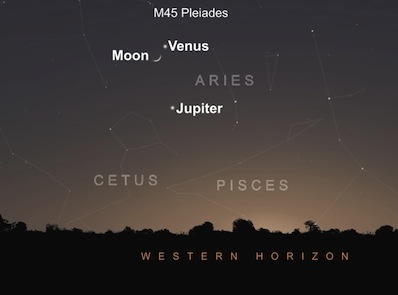
The Moon joins Venus
and Jupiter
MARK ARMSTRONG
ASTRONOMY NOW
Posted: 25 March 2012


Stargazers are in for a real treat the next few days when a young crescent moon joins Venus and Jupiter in the western sky shortly after sunset. On 25 March at around 7pm UT (around 30 minutes after sunset from London) a three day-old crescent moon, 8.7 percent illuminated, lies 3.5 degrees north-west of Jupiter. Jupiter is still an impressive sight at mag. -2.1 but it is totally overshadowed by dazzling Venus, over two magnitudes brighter at mag. +4.4 and lying about ten degrees north-east of the gas giant. The very pretty scene is further enhanced by the lovely Pleiades open cluster (M45) which is under ten degrees north-east of Venus.

The young crescent moon is close to dazzling Venus on the evening of 26 March. AN graphic by Greg Smye-Rumsby.
The next evening, 26th March, sees the crescent moon move northwards for an even closer encounter with Venus, the two separated by just over two degrees, and then passes five degrees south-east of M45 on 27 March. Venus reaches greatest elongation east of the Sun (46 degrees) on 27 March and sets over four hours after the Sun. The sky becomes astronomically dark around 8.20pm from London (Sun 18 degrees below the horizon) when Venus is still over 20 degrees above the horizon. If the skies are clear do try to observe Venus as it is almost startlingly bright!
Through a small telescope Venus will exhibit a half-phase with an apparent diameter of almost 24 arcseconds. As Venus heads back towards the Sun its phase will steadily decrease as its diameter increases. Swing the ‘scope over to Jupiter to be rewarded with a much larger disc with its major belts and zones visible along with its attendant Galilean satellites. Jupiter can’t be observed in a dark sky at a decent altitude now and it’s best to observe it as early as possible before it all too soon sinks into the western murk.
|



